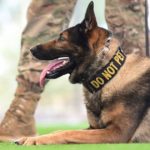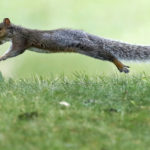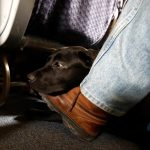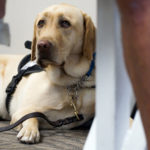Bad News About Those COVID-Sniffing Dogs
August 12, 2020

With dogs, the nose knows. Whether it’s random patches of grass, what’s cooking on the stove, dead things, or people’s crotches, dogs want a whiff. While humans have just 6 million olfactory receptors, dogs have about 300 million, giving them a sense of smell scientists estimate is between 10 to a 100,000 times more sensitive than ours. (That is, admittedly, a big range.) Their excellent noses can sniff out things we humans never could, which is why you see bomb and drug dogs working with law enforcement. But dogs aren’t just cops; they can also be trained to sniff out illnesses, like COVID-19.
Over the past several months, several teams of researchers have been training dogs on what COVID-19 smells like, in hopes they can detect it in humans. In some places, like the Dubai airport, dogs are already being deployed to sniff samples from potentially ill travelers. COVID-sniffing dogs might seem like the future, but there are real logistical challenges we’ll need to figure out first.
First, it’s quite the process to train dogs to sniff out cases of COVID-19, and it’s basically impossible to do unless you have a research lab and considerable equipment at your disposal. (This will likely be a disappointment for my dad, who texted me a news story at the beginning of the pandemic about COVID-sniffing dogs with the message: “Please train your dog.”) When researchers train dogs to recognize COVID-19, they’re actually training dogs to recognize the smells that people with the illness make, not the virus itself, which doesn’t have a smell. As your body works to fight the virus, it releases what researchers call “volatile organic compounds”—and smells differ depending on the specific ailment. Dogs have also been trained to sniff out malaria, cancer, diabetes, tuberculosis, and a whole host of other diseases.
To train dogs, researchers must first safely collect samples from people—their saliva, sweat, or urine—and test them for COVID-19. Then, researchers treat samples to render the virus inactive to make sure no dogs are exposed. (That’s a relief to this dog lover, given how the jury is still out on whether dogs can get COVID-19.) Samples are then placed in special containers; dogs’ sense of smell is good enough that they can still get a solid whiff without direct exposure to what’s inside. Researchers at the University of Pennsylvania’s School of Veterinary Medicine are currently training dogs to identify COVID-19-positive samples, and a research memo sent to me by their communications director says that the containers used to hold saliva and urine samples has a special filter that allows dogs to sniff without direct contact, which is “the equivalent of dogs wearing an N95 mask.”
Those samples are often kept in special steel contraptions or cubby holes specifically designed to allow dogs’ snouts to fit inside and access containers while preventing them from directly disturbing the samples. Researchers then use positive reinforcement to train dogs: When dogs successfully sniff out a positive sample, they get a treat or a ball.
A dog sniffs at a metal contraption.
A dog in training to detect COVID-19 infections in humans, July 24 in Ulmen, Germany. Andreas Rentz/Getty Images
With dogs, the nose knows. Whether it’s random patches of grass, what’s cooking on the stove, dead things, or people’s crotches, dogs want a whiff. While humans have just 6 million olfactory receptors, dogs have about 300 million, giving them a sense of smell scientists estimate is between 10 to a 100,000 times more sensitive than ours. (That is, admittedly, a big range.) Their excellent noses can sniff out things we humans never could, which is why you see bomb and drug dogs working with law enforcement. But dogs aren’t just cops; they can also be trained to sniff out illnesses, like COVID-19.
Over the past several months, several teams of researchers have been training dogs on what COVID-19 smells like, in hopes they can detect it in humans. In some places, like the Dubai airport, dogs are already being deployed to sniff samples from potentially ill travelers. COVID-sniffing dogs might seem like the future, but there are real logistical challenges we’ll need to figure out first.
First, it’s quite the process to train dogs to sniff out cases of COVID-19, and it’s basically impossible to do unless you have a research lab and considerable equipment at your disposal. (This will likely be a disappointment for my dad, who texted me a news story at the beginning of the pandemic about COVID-sniffing dogs with the message: “Please train your dog.”) When researchers train dogs to recognize COVID-19, they’re actually training dogs to recognize the smells that people with the illness make, not the virus itself, which doesn’t have a smell. As your body works to fight the virus, it releases what researchers call “volatile organic compounds”—and smells differ depending on the specific ailment. Dogs have also been trained to sniff out malaria, cancer, diabetes, tuberculosis, and a whole host of other diseases.
To train dogs, researchers must first safely collect samples from people—their saliva, sweat, or urine—and test them for COVID-19. Then, researchers treat samples to render the virus inactive to make sure no dogs are exposed. (That’s a relief to this dog lover, given how the jury is still out on whether dogs can get COVID-19.) Samples are then placed in special containers; dogs’ sense of smell is good enough that they can still get a solid whiff without direct exposure to what’s inside. Researchers at the University of Pennsylvania’s School of Veterinary Medicine are currently training dogs to identify COVID-19-positive samples, and a research memo sent to me by their communications director says that the containers used to hold saliva and urine samples has a special filter that allows dogs to sniff without direct contact, which is “the equivalent of dogs wearing an N95 mask.”
Those samples are often kept in special steel contraptions or cubby holes specifically designed to allow dogs’ snouts to fit inside and access containers while preventing them from directly disturbing the samples. Researchers then use positive reinforcement to train dogs: When dogs successfully sniff out a positive sample, they get a treat or a ball.
Not only does this training require some special equipment, but it’s also fairly time-intensive. In one study by German researchers, dogs were intensively trained for a week, smelling more than 1,000 samples. That’s a lot of treats! And those were dogs already trained in scent detection, a relatively small and elite population. Dogs with no previous training would need anywhere from three to six months to learn, according to an op-ed in the Conversation from Anne-Lise Chaber and Susan Hazel, animal cognition researchers from the University of Adelaide. Not all dogs who start the training will be up to snuff; just as some work or service dogs turn out to be better pets, some COVID-smelling dogs might turn out to be better suited for a life of leisure.
There’s also evidence that what happens in the lab may not adequately prepare dogs for what they’d need to do in the real world. In many cases, dogs are trained using a consistent ratio of positive to negative samples; for instance, in training the German study, dogs sniffed 1 positive case for every 6 negative samples and were tested at a ratio of about 1 positive to 5 negative samples. But that ratio is highly unlikely in the real world. (Hopefully, you’ll find only a small number of cases among the thousands of travelers.)
That could spell trouble for real-world screenings. Previous research on cancer-sniffing dogs suggests that changing up the consistency of positive to negative cases can throw dogs off, so the same issue could occur with COVID detection. In a cancer detection study, researchers emulated a real-world scenario by moving away from a training and testing regime that depended on those strict, fixed ratios. Instead, they trained dogs for six months without using any specific ratio, and when they finally could correctly identify 1 positive sample to every 5 negative samples, they “graduated” to a testing phase, where they were given five samples, which contained a random number of positives. One dog may have gotten zero positives among the five samples; another could have sniffed five samples that were all positive. Dogs’ accuracy was much lower, which, the authors say, is an indication that methods need to be refined if dogs are expected to screen samples effectively.
With all the media attention, Penn Vet’s communications director Martin Hackett says that they “have been receiving a sizable amount of preliminary interest from organizations, entities, municipalities, states, other countries—all expressing interest in employing COVID canine scent detection.” Before that happens, though, researchers and these entities will need to implement plans for how, exactly, dogs’ sniff tests will be administered, and how the results will be used.
In the Dubai airport, for example, officials take samples from travelers and then have dogs sniff the samples, rather than the people directly. That might look different in the U.S.; from Penn Vet’s plans, it appears dogs may be sniffing through crowds of people directly, rather than indirectly sniffing folks through samples. If that’s the case, we will likely want more definitive information about how the virus affects dogs, and whether they are able to spread it from person to person.
We’ll also need to get on the same page about how dogs’ input will be interpreted in these screenings. Though early studies have shown dogs can achieve a high level of accuracy—in that German study, the average accuracy of a dog was about 94 percent—dogs’ abilities are certainly imperfect. The standard nasal swab COVID-19 tests are not perfectly accurate, either, and may not detect small viral loads; similarly, dogs’ sensitivity to samples might vary depending on viral load. In Dubai, the dogs are presented as a “backup” precaution, not a direct determinant of whether people can get on planes; the United Arab Emirates already requires travelers to present evidence of a negative PCR COVID-19 test. Knowing that dogs could make mistakes, we’d likely want to set up a protocol for what happens after a dog identifies a person or sample that is potentially COVID-positive. Will they need to submit to a rapid COVID-19 test to be allowed entry to a sports arena or the airport, or will they just immediately be turned away?
While COVID-sniffing dogs could certainly be a helpful new technology, these logistical and ethical concerns may make the entire enterprise more trouble than it’s worth. For instance, a LiveScience piece points out that the first paper suggesting dogs could help sniff out cancer was published in 1989, but it’s never really caught on because of how time-consuming the training is, and how hard it is to keep the dogs engaged in the field, where they can’t be immediately rewarded for a job well done—you can’t wait until a case is confirmed to give a dog a treat. Similarly, after promising preliminary results showing dogs can identify malaria or Parkinson’s disease, we have yet to see dogs being deployed for screenings. The benefits of training these dogs outweigh the new insights, as our existing diagnostic tools are still more readily available and easier to deploy. In any case, I advocate for these intrepid scent-detecting dogs to continue to receive their regular treats, even outside of training, for being very, very good.
Future Tense is a partnership of Slate, New America, and Arizona State University that examines emerging technologies, public policy, and society.






